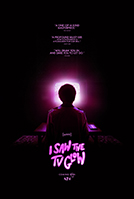I Saw The TV Glow

| Original title: | I Saw The TV Glow |
| Director: | Jane Schoenbrun |
| Release: | Cinema |
| Running time: | 100 minutes |
| Release date: | 03 may 2024 |
| Rating: |
Mulder's Review
When I first heard that Jane Schoenbrun's indie horror film I Saw the TV Glow was partly an homage to Buffy the Vampire Slayer, my excitement was through the roof. As a die-hard Buffy fan, I was eager to see how this film would capture the blend of humor, horror, and angst that made Buffy so iconic. What I found was a deeply evocative film that explores identity, loss, and the life-saving potential of television in a profoundly moving way.
I Saw the TV Glow is set in a nondescript suburban town, possibly named Void, which sets the tone for the film's eerie, lo-fi atmosphere. The protagonist, Owen, played heartbreakingly by Justice Smith, is a young outsider who discovers The Pink Opaque, a show eerily reminiscent of Buffy. This show becomes his lifeline as he navigates the trials of adolescence and grief. Introduced to the show by fellow outsider Maddy (Brigette Lundy-Paine), Owen finds solace and identity in its episodes, making The Pink Opaque a crucial element in their lives.
The film opens with a young Owen, portrayed by Ian Foreman, who stumbles upon The Pink Opaque in seventh grade. Maddy, an older and cooler ninth-grader, becomes his guide into this world, much like Giles did for Buffy. The show within the film stars Helena Howard and Lindsey Jordan (of Snail Mail) as Isabel and Tara, two girls psychically bonded in their quest to vanquish a moon-like Big Bad named Mr. Melancholy. This narrative is explicitly based on Buffy, right down to the tone, title font, and indie rock score.
The Pink Opaque not only reflects the supernatural elements of Buffy but also mirrors the personal struggles of Owen and Maddy. Both characters are outsiders, much like Buffy and her Scooby Gang, and find a sense of purpose and belonging through their connection to the show.
The film delves deep into the emotional lives of its characters. Owen’s journey is one of profound grief and identity search. His mother, who was doting to the point of being a helicopter parent, dies of cancer, leaving him in the care of his distant, television-obsessed father. Owen's fear and reluctance to leave his hometown contrast sharply with Maddy's desperate desire to escape her abusive home life.
Maddy, who is empowered by The Pink Opaque to embark on her own hero’s journey, eventually disappears, leaving only a burning TV behind. This act symbolizes her breaking free from the oppressive confines of her life, driven by the show's influence. Owen, on the other hand, remains trapped, his potential wasted in the stifling environment of his small town.
I Saw the TV Glow is filled with hauntingly beautiful imagery that stays with you long after the credits roll. The constant glow of television sets, the billowing planetarium tent, the sensory-numbing amusement park, and the neon pink birthmarks of the show's protagonists are all visually striking. In one of the film’s most intimate scenes, Maddy draws the pink birthmark on Owen’s neck, symbolizing their deep bond and shared identity.
The film also captures the sinister, nightmarish quality of genuine horror. Schoenbrun, who is transfeminine, taps into the queer subtext of Buffy, exploring themes of outsider status, divine purpose, and the fight against personal demons. The influence of local filmmaker Albert Birney is evident in the construction of the film's monsters, adding a layer of genuine fright that complements the psychological horror.
I Saw the TV Glow explores the transformative power of television, especially for young, queer individuals. For Owen and Maddy, The Pink Opaque is more than just a show; it’s a lifeline, a portal to a better world. Schoenbrun's film underscores the idea that television can be a source of identity and purpose, offering a sense of belonging to those who feel like outsiders.
The film's narrative, set mostly in the late ’90s, feels like a period piece that nostalgically reflects on a time when television was a crucial, unifying force. Schoenbrun doesn’t condemn television but rather pays tribute to its ability to mesmerize and even save lives. This is particularly resonant for those who, like Owen, found solace in shows like Buffy during their formative years.
I Saw the TV Glow is a deeply evocative and hauntingly beautiful film that explores identity, loss, and the life-saving potential of television. Jane Schoenbrun has crafted a narrative that honors the legacy of Buffy while delving into the personal and emotional struggles of its characters. For those who found themselves in shows like Buffy, Schoenbrun's film is a must-see, offering a poignant reflection on the impact of media on our lives.
In a world where television shows can be more than just entertainment, I Saw the TV Glow stands out as a testament to the power of storytelling and its ability to connect, heal, and transform.
I Saw the TV Glow
Written and directed by Jane Schoenbrun
Produced by Emma Stone, Dave McCary, Ali Herting, Sam Intili, Sarah Winshall
Starring Justice Smith, Brigette Lundy-Paine, Helena Howard, Lindsey Jordan, Conner O'Malley, Emma Portner
Ian Foreman, Fred Durst, Danielle Deadwyler
Cinematography : Eric K. Yue
Edited by Sofi Marshall
Music by Alex G
Production companies : Fruit Tree, Smudge Films, Hypnic Jerk, Access Entertainment
Distributed by A24
Release dates : January 18, 2024 (Sundance), May 3, 2024 (United States)
Running time : 100 minutes
Viewed on June 15, 2024
Mulder's Mark:

